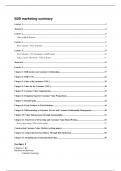Samenvatting
Summary Thermodynamics
- Instelling
- Radboud Universiteit Nijmegen (RU)
This is a complete summary of the course Spectroscopic Techniques. Includes information from the lecture notes, the book and the student manual. The book used for this course is Physical Chemistry 10th edition from Atkins and De Paula. Chapters Physical Chemistry: 1 (A-C), 2 (A-C, E), 3 (A-D), 5(A...
[Meer zien]














